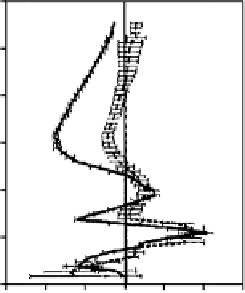Geoscience Reference
In-Depth Information
Neutral winds
200
Zonal
180
Merid.
160
140
120
100
80
2150
2
100 250
0
50
100
150
Velocity (m/s)
Figure 3.33
Neutral wind profile derived from one TMA rocket release. [After Larsen
and Odom (1997). Reproduced with permission of the American Geophysical Union.]
that such waves increase in amplitude as they propagate upward. Upward-
propagating tides have the same property, so quite substantial winds can occur
in the upper atmosphere. A plot of the wind field determined from a rocket
trail measurement is presented in Fig. 3.33. The data were obtained from one of
the several hundred trail observations made since 1960. Tri-methyl aluminum
(TMA) is the chemical of choice, since it burns in the rich atomic oxygen envi-
ronment for several tens of minutes. Using triangulation, the winds can be mea-
sured as a function of altitude from 80 to 130 km. These large winds are typical
of TMA observations over the years (Larsen, 2002) and represent a problem for
theoreticians: Such large values are not predicted by the models.
Observations such as those presented in Fig. 3.33 indicating 100m/s winds
in the lower thermosphere are quite remarkable and are not as yet explainable
by tidal theory. We postpone discussion of these ubiquitous high winds until
our discussion of gravity waves in Chapter 6. These large winds are accom-
panied by large shears, shears large enough to be dynamically unstable to the
Kelvin-Helmholtz instability. We investigate this neutral atmospheric process in
Chapters 4 and 6 because it leads to turbulence and small-scale structure in both
the atmosphere and the ionosphere. Such effects are likely to occur at all lati-
tudes, but very few equatorial observations exist at this point. We thus postpone
discussion of the winds to later chapters.
These high winds have, for the most part, been ignored by theorists and
experimentalists, but the data in Fig. 3.33 suggest that this is not a good idea!
Also, considering Fig. 3.17b, classic electrojet theory would yield
J
,
but this is clearly not the case. The difference can only be due to the current
ne
/
ne
=|
E
/
B
|
=
ν
i
neu
where
u
is the zonal neutral wind that, in this case, must be

Search WWH ::

Custom Search